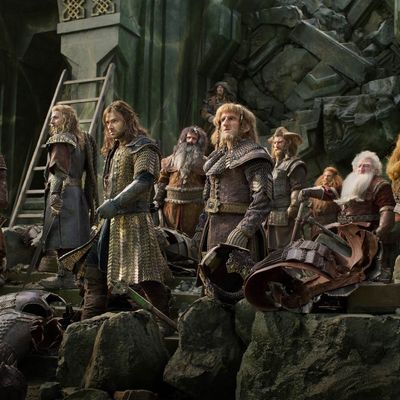
This third installment of The Hobbit trilogy is allegedly the shortest of all of Peter Jackson’s Tolkien films, but my theater must have been orbiting a black hole because I could swear it swallowed up 20 years of my life. Maybe it was all that slow-motion. Or maybe it was the fact that, more than any of the other films in Jackson’s ill-advised (but ridiculously lucrative) trilogy, The Hobbit: The Battle of the Five Armies feels thoroughly inconsequential — a bloated, portentous mess that, in a just world, should not exist.
I realize we’re a long way from Tolkien’s original novel here. (Remember that spry, quick-witted, briskly told fantasy that started this entire enterprise in the first place?) But it’s still worth noting that the so-called “Battle of the Five Armies” is confined in that book to a few cursory paragraphs near the end — an ironic, pointed bit of downplaying on the author’s part. The most interesting aspect of the battle is the fact that Bilbo Baggins — the protagonist of the book and, to some extent, the films — spends most of it on the sidelines and/or invisible, hiding from the “terrible” fighting. In other words, in just a page or two, Tolkien conveys the awfulness, and the sheer pointlessness, of war. But for Peter Jackson, war is not pointless; it’s an excuse. So now we have an entire movie built around said battle, loaded up with inane spectacle, with face-offs and collapsing bridges (do bridges ever stay intact in these goddamn films?) and vast vistas of armies thundering toward one another.
To what end? Most of what could be called a plot in The Battle of the Five Armies is spent tying up threads you might not even remember from the earlier films. Bilbo (Martin Freeman), as you may recall, had been traveling with a group of dwarves led by Thorin Oakenshield (Richard Armitage) in an attempt to reclaim the Lonely Mountain, which had been taken over by the ghastly dragon Smaug (voiced by Benedict Cumberbatch). Now the dwarves have the Mountain, and Smaug is threatening a nearby village of men. The devastation wrought by the dragon, and the attempts of Bard (Luke Evans), a heroic warrior and family-man, to kill it are probably the best parts of this latest entry. Even if you don’t particularly recall Bard from the previous film, you can at least get with the idea that the guy needs to save his burning, ruined village and his terrified family.
Meanwhile, Thorin, the king of the dwarves, is now in the grip of some kind of mania that makes him hoard the treasure of the mountain they’ve claimed from Smaug. He’s clearly not himself — but again, you’ll have to remember him from the earlier films to remember what his “self” was even like. But Jackson spends an almost comical amount of time watching Thorin rant and mope. It’s as if he’s filmed himself into a corner, having spent so much time in this series on random bits of action and minor character exchanges that, now that something important is happening, he really has to waste a lot of precious screentime on it. Meanwhile, aside from Thorin, I still can’t name any of these dwarves, and I’ve spent three movies watching them. (In comparison, at a similar point in the Lord of the Rings films, I could have easily named just about every single major character and identified a few of their major traits.) Anyway, in part thanks to Thorin’s pigheadedness, the titular battle soon ensues. And it is terrible, and it is elaborate, and it is long. The action is handled relatively smoothly — Jackson may have lost his soul as a filmmaker, but he hasn’t lost his proficiency — but it’s all in the service of an empty cause, as we’re asked to care about characters these films have done very little to develop. Bilbo, the ostensible hero of this tale, spends most of the battle doing nothing.
It didn’t need to be this way. Remember how wonderful — funny, fast, beautiful, emotional — Jackson’s Lord of the Rings films were? Even The Desolation of Smaug, the second entry in this new series, had enough to recommend it. Its best bits involved an elaborate spider attack and Bilbo’s battle of wits against Smaug. No spider attack can be found here — instead, we get that aforementioned giant, protracted battle full of people we don’t particularly care about doing warlike things to each other. And Smaug, believe it or not, isn’t in the film for that long, either. What I was most frustrated by, though, was how relatively little was given to Tauriel (Evangeline Lily), the woman warrior-elf who kicked so much wondrous ass in that earlier film. A creation entirely of Jackson and his team’s, Tauriel had brought a jolt of energy, humanity, and unpredictability to the story. She’s definitely still here, but now she finds herself mostly reduced to being a victim during the war. Instead, Jackson and Co. have again airlifted in Legolas (Orlando Bloom, starting to look a wee bit jowly but presumably eager for the work) to do the requisite bit of acrobatic fighting. It all begs the question: Why go to the trouble of creating a great female elf-hero only to have her upstaged by another elf-dude? But why should that surprise us? Over and over again, these Hobbit films have been characterized by their missteps. Good riddance. Enjoy your mountain of gold, King Jackson.


